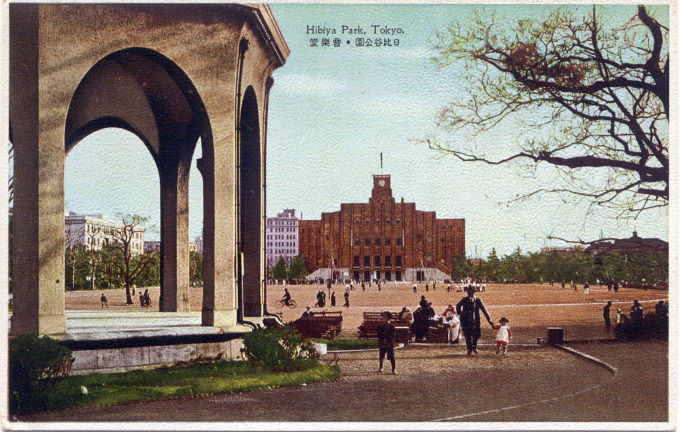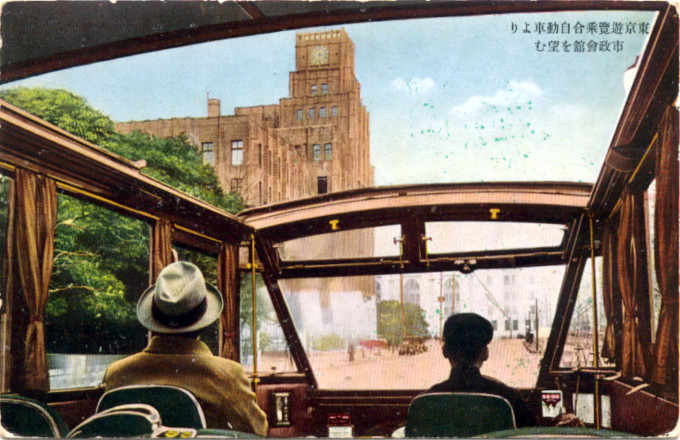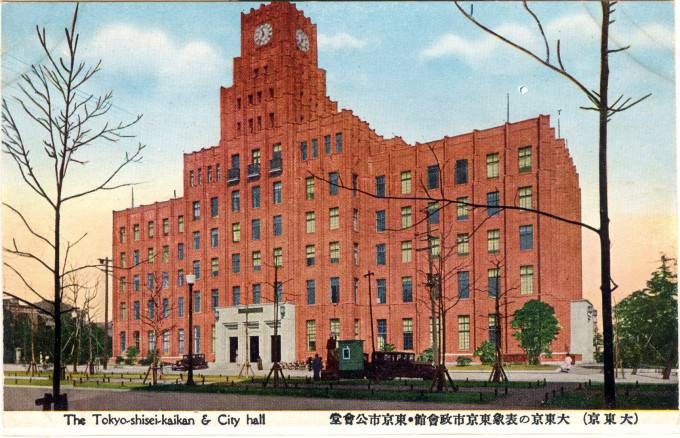
Looking across Hibiya Park at Hibiya Public Hall, completed in 1929 on the southeastern edge of the park. The building once housed the Domei Tsushin state wire service and its postwar successors, Kyodo News and Jiji Press.
See also:
Hibiya Park, c. 1910
Hibiya Public Hall [Shisei Kaikan, ‘City Hall’], in part a public facility and in part the offices of the Tokyo Institute of Municipal Research, is located on the southeastern corner of Hibiya Park. The ten-story steel-frame reinforced concrete structure is finished in terra cotta, Yokonezawa stone (quarried in Shizuoka Prefecture), and the light brown scratch tile so popular in the 1920s.
Construction was completed in 1929, a symbol of Tokyo’s rebirth after the devastating 1923 Great Kanto earthquake, and the hall is still in use today for concerts, lectures, meetings and other cultural activities. In 1960, Hibiya Public Hall gained notoriety as the site where Asanuma Inejiro, chairman of the Japan Socialist Party, was assassinated by a sword-wielding student.
“Toshiya at 11 received the first prize in a newspaper music contest sponsored by the Ministry of Education. The required composition was Back’s A minor Concerto. Little Koji, who was seven, could play the piece beautifully. Suzuki [Shinichi] wanted the judging committee to understand clearly that even a Japanese who was only seven years old could reach that level and pass the test, and so he ask them to let Koji play even though he was younger than the required age.
“… In 1935, Suzuki received two appointments to teach violin. One was a full-time position at the Imperial Music School in Tokyo, and the other, at Kunitachi Music School … Among those very first students was Teiichi Tanaka, a boy of five who was sightless.
“… Suzuki realized that for Teiichi to play he must develop a different kind of ‘sense of sight,’ a sixth sense, or Kan. Together they set about to develop this Kan, and soon he was able to play as well as the other students. In 1942 when Suzuki presented his very young students in concert for the first time, some 30 students performed at Hibiya Hall. Along with Yoko Arimatsu, Koji Toyoda, Takeshi Kobayashi, and Kenji Kobayashi, little Teiichi performed a Seitz Concerto.”
– Shinichi Suzuki: The Man and His Philosophy (Revised), by Evelyn Hermann, 1981



